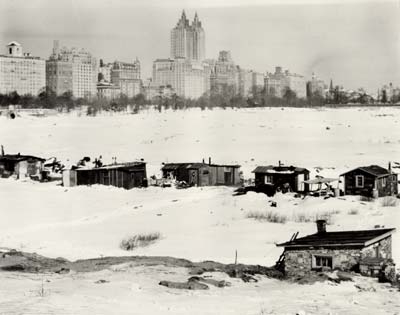I chose Central Park for my “Then and Now” blog post because it is one of the few places in New York that has largely remained constant throughout the years. While people, places, and things have come and gone throughout the city, many areas within Central Park look just as they did over a century-and-a-half ago. Central Park allows visitors to travel to any time period between the present and its creation. The rock you lay upon today has been laid upon by countless people before you, and they very likely gazed upon the same field or grove of trees.
In 1857 Frederick Law Olmsted’s proposal was the winner of a design contest for the layout of the park. By the mid 1860s, millions were visiting the park each year. Attractions, including concerts, the carousel, tennis, bicycling, and the ever popular Central Park Zoo brought more and more visitors to the park throughout the rest of the nineteenth century.
The twentieth century was a dynamic one for Central Park. Central Park’s famous Great Lawn was once a large rectangular reservoir. Not long after the stock market crashed, the reservoir was drained as the City no longer wished to maintain it. Plans for its re-purposing slowed and thus a large empty basin was left. “Hoovervilles” sprang up in place of the reservoir. Said one man regarding his shack, “We work hard to keep it clean, because that is important. I never lived like this before.” In 1932, the Parks Department referred to the emptied reservoir as Hoover Valley. The New York Times states that “As the Depression set in, public sentiment became more sympathetic. In July 1931 a judge suspended the sentences of 22 unemployed men sleeping in Central Park — apparently in various locations — and gave each one $2 out of his own pocket.”
In 1934, Robert Moses took charge of the City’s parks, acquired federal funds, and “built 20 playgrounds on the park’s periphery, renovated the Zoo, realigned the drives to accommodate automobiles, added athletic fields to the North Meadow, and expanded recreational programming.” These were lasting amendments to the park that still exist today.
The Central Park Conservancy was formed by a group of concerned New Yorkers after the park, like much of the city, went through a period of great decline in the 1970s. They now handle the majority of the parks operations, and are mostly privately funded. Today the park is constantly being maintained and refurbished and remains a free alternative for New Yorkers, even during times of financial distress.
Sources:
1) http://www.centralparknyc.org/
2) http://www.nytimes.com/1993/08/29/realestate/streetscapes-central-park-s-hooverville-life-along-depression-street.html?pagewanted=2&src=pm
3) http://www.centralpark.com/guide/history.html





You’ve made a good start here. However, since the ideal blog post is one that an outside reader could understand, you need to be clearer in your descriptions of the past and to explain some aspects of the post a bit better. For example, why did parks officials decide to drain the reservoir? What was the park like by the time Moses helped fix it up (feel free to quote Caro)? What was a “Hooverville”? And why did the park go through a period of decline? Obviously, the focus of the piece should be the Depression-Recession idea, but the post would still benefit from a few more telling details, as well as a few more visuals.
Also, a lot of your prose here is passive and/or a bit rough. You know what the former is, but here’s an example of the latter: “After going through a period of decline during the 1970s, the Central Park Conservancy…” This kind of small problem detracts from the larger narrative.
Sourcewise, you need to indicate in the text itself where you’ve gotten your quotes. And rather than pasting in internet photos, I’d like to see you go to the park yourself and take these pictures.
Central Park has always been one of my favorite places. I used to live on 72nd and Amsterdam and I would literally spend everyday of the summer at Central Park. I like the picture of the Central Park Hoovervilles and like Professor Brooks mentioned, it would be nice to see pictures that you have taken at Central Park.
Hey, Nicholas! This post is engaging and well-researched. By providing background information on Central Park in the 19th century, you helped me realize the true extent of the park’s permanence.
There is something very unique about the contrast of nature in Central Park and man-made buildings surrounding it. Nice introduction as well! It really grabbed my attention.